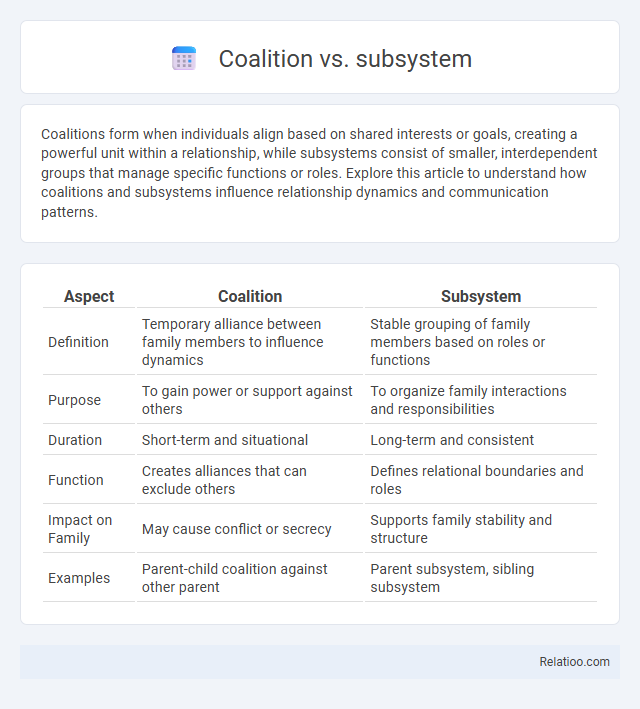Coalitions form when individuals align based on shared interests or goals, creating a powerful unit within a relationship, while subsystems consist of smaller, interdependent groups that manage specific functions or roles. Explore this article to understand how coalitions and subsystems influence relationship dynamics and communication patterns.
Table of Comparison
| Aspect | Coalition | Subsystem |
|---|---|---|
| Definition | Temporary alliance between family members to influence dynamics | Stable grouping of family members based on roles or functions |
| Purpose | To gain power or support against others | To organize family interactions and responsibilities |
| Duration | Short-term and situational | Long-term and consistent |
| Function | Creates alliances that can exclude others | Defines relational boundaries and roles |
| Impact on Family | May cause conflict or secrecy | Supports family stability and structure |
| Examples | Parent-child coalition against other parent | Parent subsystem, sibling subsystem |
Introduction to Coalition and Subsystem
A coalition is a dynamic alliance of independent entities collaborating to achieve shared goals while maintaining their individual autonomy. Subsystems refer to smaller, interconnected components within a larger system that operate together to fulfill specific functions. Understanding coalitions and subsystems highlights the contrast between collaborative networks versus integrated parts of a unified system.
Defining Coalition: Key Features
A coalition refers to a strategic alliance where multiple entities collaborate toward a common goal while maintaining their individual independence. It emphasizes shared resources, coordinated efforts, and mutual benefit without the full integration typical of a subsystem. Key features include flexible membership, joint decision-making, and the ability to dissolve once objectives are met.
Understanding Subsystem: Core Concepts
A subsystem is a distinct functional unit within a larger system, designed to perform specific tasks contributing to the overall system objectives. Unlike a coalition, which is a strategic alliance of independent entities working together temporarily for common goals, a subsystem operates continuously as an integral component within a single system's architecture. Understanding subsystems involves analyzing their modular design, interdependencies, and roles in enhancing system efficiency, reliability, and scalability.
Differences Between Coalitions and Subsystems
Coalitions are temporary alliances formed by actors with shared interests to influence a specific decision or policy, while subsystems encompass a stable network of actors including coalitions, bureaucracies, and interest groups interacting within a policy domain over time. The primary difference lies in their scope and duration: coalitions are issue-specific and short-term, whereas subsystems represent long-term, institutionalized interactions within a policy area. Subsystems provide the structural framework within which multiple coalitions emerge, compete, and evolve around different policy issues.
Roles and Functions in Systems Theory
Coalition roles involve temporary alliances among system components to achieve specific goals, emphasizing collaboration and resource sharing. Subsystems function as distinct, interdependent units within a larger system, each managing specialized tasks crucial to overall system stability and efficiency. Your understanding of these dynamics enhances system analysis by clarifying how coalitions and subsystems interact to maintain functionality and adapt to change.
Examples of Coalitions in Practice
Coalitions in practice often involve alliances such as political parties uniting to form government majorities, or international groups like NATO collaborating on defense strategies. In contrast, subsystems function as smaller, specialized units within larger organizations or systems, like the finance department within a corporation. Your understanding of these distinctions helps in recognizing how coalitions drive collective action, while subsystems support operational functions within broader entities.
Subsystems in Organizational Structures
Subsystems in organizational structures function as semi-autonomous units within a larger system, each responsible for specific tasks or functions that contribute to overall organizational goals. Unlike coalitions, which are temporary alliances formed to achieve particular objectives, subsystems maintain continuous operations and stable roles, ensuring efficiency and specialization. Effective management of these subsystems enables seamless coordination and integration, enhancing organizational adaptability and performance.
Advantages and Limitations of Coalitions
Coalitions offer the advantage of combining diverse resources and expertise from multiple agents to achieve complex goals that single subsystems cannot handle alone, enhancing overall system robustness and flexibility. However, coalitions face limitations such as increased coordination complexity and potential conflicts among agents, which can lead to inefficiencies or slower decision-making processes. Your system's performance depends on balancing these coalition benefits with challenges in communication and alignment of objectives.
When to Use Subsystems vs. Coalitions
Subsystems are ideal when you need to organize components within a system based on shared functions or relationships, providing modularity and clear internal boundaries. Coalitions are best used when independent systems or groups collaborate temporarily to achieve a common goal without merging their internal structures or responsibilities. You should use subsystems for structural integration and coalitions for flexible, goal-oriented cooperation between autonomous entities.
Conclusion and Practical Implications
Coalition, Subsystem, and Coalition represent distinct yet interconnected organizational structures influencing team dynamics and decision-making processes. You should consider Coalitions for leveraging alliance-based power, while Subsystems offer specialized functional expertise within larger systems, enhancing operational efficiency. Practical implications suggest tailored management strategies to optimize collaboration, power balance, and resource allocation for improved organizational outcomes.

Infographic: Coalition vs Subsystem
 relatioo.com
relatioo.com